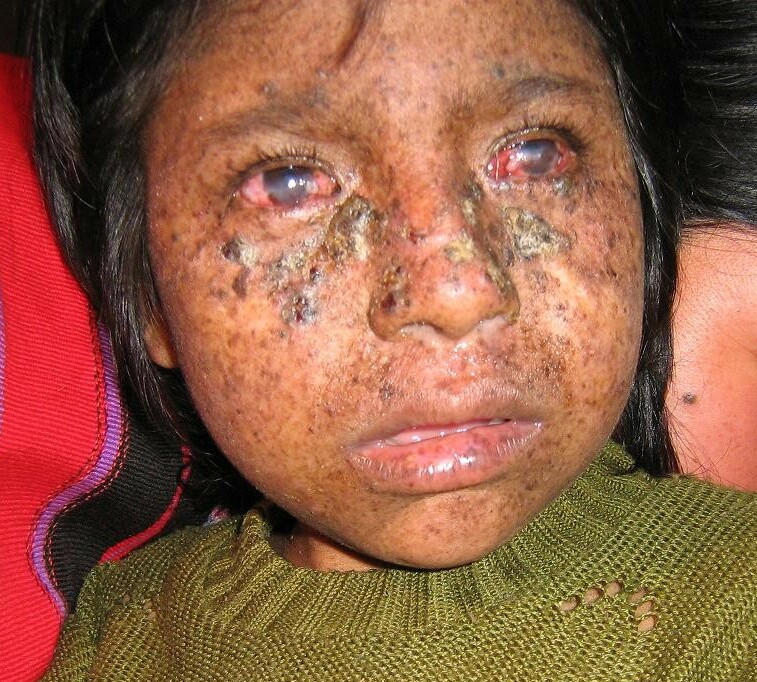Xeroderma Pigmentosum

Xeroderma pigmentosum (XP) is a rare genodermatosis characterized by extreme sensitivity to ultraviolet (UV)-induced changes in the skin and eyes, and multiple skin cancers. It is subdivided into 8 complementation groups, according to the affected gene: classical XP (XPA to XPG) and XP variant (XPV) (see these terms).
Epidemiology
It has an estimated prevalence of 1/1,000,000 in the USA and Europe, with higher figures in other countries (e.g. Japan, North Africa and Pakistan), particularly in communities with a high degree of consanguinity.
Clinical description
The severity of the clinical manifestations and the age of onset are extremely variable and are in part dependent on exposure to sunlight and the complementation group. Approximately 50% of affected individuals have acute sun sensitivity from the first few months of life, presenting with severe sunburn and/or persistent erythema which takes weeks to resolve. Others do not show any sunburn reaction and gradually develop marked freckling at sun exposed sites. Individuals have dry skin and hypo- or hyperpigmented lesions. There is a greater than 10,000-fold increased risk of non-melanoma skin cancers, and a 2,000 fold increased risk of melanoma under the age of 20 when compared to the general population. Patients with classical XP develop skin cancer generally before the age of 20, while patients with XP variant start to develop skin cancer at about 20-30 years of age. Ocular abnormalities include keratitis resulting in corneal opacification and vascularization. Photophobia is common. Ocular squamous cell carcinoma and melanoma are common. Neurologic abnormalities of varying severity have been reported in about 30% of cases. These include acquired microcephaly, diminished or absent deep tendon stretch reflexes, progressive sensorineural hearing loss, spasticity, ataxia, seizures and progressive cognitive impairment. De Sanctis-Cacchione syndrome is a term that was originally attributed to XP cases with severe neurological abnormalities but it is no longer in general use.
Etiology
XP is caused by mutations in 8 genes involved in DNA repair. Seven of these genes, XPA to XPG (ERCC5), are involved in nucleotide excision repair (NER). XPV, or POLH, encodes the DNA polymerase eta, which is required to replicate DNA containing UV-induced damage.
Diagnostic methods
Diagnosis is based on clinical symptoms and is confirmed by cellular tests for defective DNA repair (e.g. unscheduled DNA synthesis (UDS) test in cultured skin fibroblasts) and UV hypersensitivity. Reduced UDS and hypersensitivity to UV-induced killing confirm the diagnosis of XP. A normal UDS and specific sensitivity to UV in the presence of caffeine confirm the diagnosis of XP variant.
Differential diagnosis
Differential diagnoses include trichothiodystrophy, Cockayne syndrome, cerebrooculofacioskeletal syndrome (COFS), UV-sensitive syndrome, erythropoietic protoporphyria, and Rothmund-Thomson syndrome (see these terms).
Antenatal diagnosis
Prenatal diagnosis through measurement of UDS in cultured chorionic villus cells or amniocytes has been reported.
Genetic counseling
Transmission is autosomal recessive.
Management and treatment
Patients must avoid sun exposure (application of sun cream, UV protective clothing, indoor protection with UV blocking films). Management requires a multidisciplinary approach. Regular skin and eye review and appropriate management of any cancerous lesions is essential. Vitamin D deficiency is common and supplements should be prescribed.
Prognosis
There is no cure for XP but sun avoidance and regular follow-up to assess and treat any skin cancers increases life expectancy. For those with no neurological disease and rigorous UV protection, the prognosis is good. However the neurological abnormalities are progressive and can result in a shortened lifespan.